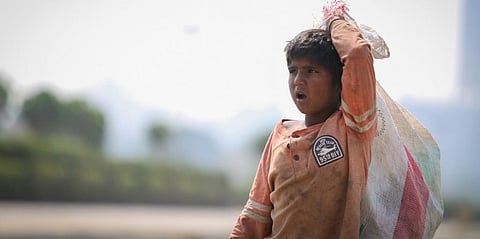Is child protection a priority in the public budget?
India’s ability to realise and help children reach their full potential is dependent on the nation’s ability to fulfil its commitments to children. The Constitution of India recognises the inherent vulnerabilities in children through Article 39-F.
The Article mandates the state to ensure that “children are given opportunities and facilities to develop in a healthy manner and in conditions of freedom and dignity and that childhood and youth are protected against exploitation and against moral and material abandonment.”
Despite this legal mandate, the realities on ground present a different picture.
Children across India face multiple vulnerabilities, whether inherent in individual characteristics, personal handicaps, birth situations, geographies and familial aspects. However, these vulnerabilities may also be the by-product of the macro-economic environments, social and culture norms and systemic imperfections.
Such issues are, often, also likely to create situations where children can be exploited, neglected, or even abused.
One such age-old malpractice where children still fall prey to is child marriage. Even today our country is home to one in every three child brides worldwide, according to a Unicef report.
Also, India’s diverse multicultural identity has been catalytic to many problems for children. Regional inequalities and complexities across Indian states and the South Asian region have resulted in the country becoming a hub, transit area and destination for child trafficking.
Data reveals that one in every five children above 14 years of age are working, many in informal, unstable, and potentially hazardous environment (Census, 2011).
Crime against children has also risen by more than 500 per cent in the past decade and one-third of all crimes against children are sexual offences, according to the 2016 report of the National Crime Records Bureau.
More than 50 cases of child rapes are registered everyday in India and every 15 minutes, a sexual offence is committed against a child in our country, it added.
These disturbing figures, therefore, point out to a significant underlying question — as a state, are we doing enough for prevention, protection and rehabilitation of most vulnerable children?
A significant way to ascertain the intent of the state is to analyse the pattern and the quantum of financial investments towards creation of a strong, proactive and fast responsive child protection system.
In 2009, the ministry of women and child development (MWCD) formulated an integrated child protection scheme (ICPS), a flagship scheme as means of safeguarding children in need of temporary or permanent care solutions, both through institutional care or non-institutional care mechanisms such as sponsorship, foster care, or adoption.
The scheme carries enforcement of protection and rehabilitation provisions under specific legislations on aspects such as juvenile justice, child labour, marriage, trafficking or abuse.
However, the overall focus of the implementation of ICPS scheme continues to be reactive and responsive; rather than being proactive, focused on prevention, ensuring justice and rehabilitation.
This limited approach leaves the child vulnerable and does little to bring the child back into a preventive protective framework. Ever since its launch, financial allocations in ICPS have indicated a trajectory of slow growth and consolidation.
Initial years of implementation were marred by low utilisations and delays in recruitment of human resources. It is therefore both justified and a welcome move that financial allocations for ICPS scheme have been substantially increased from Rs 725 crores (2018-19 budget estimates) to Rs 1,500 crores (2019-20 budget estimates).
Yet, it is vital to understand and highlight that child protection services are neither the first nor the sole response mechanism for children in a vulnerable state.
Government schemes
Government’s national crèche scheme has been lauded as a great initiative, to improve the availability and quality of care services for children and cater to the needs of working mothers.
The scheme extends working women’s access to substitute day care services providing quality care and protection for children while they are gainfully engaged. However, the recently notified maternity benefit guidelines permit only working mothers under formal employment to access day-care facilities.
A six-state study commissioned by the WCD ministry in 2013 indicated that 97 per cent women respondents would avail crèche services if they were made available.
Despite, such splendid response, allocations of Rs 50 crore for the scheme in the 2019-20 budget remains minuscule, even though it has been substantially increased by 66 per cent from Rs 30 crore allocated last year.
However, the crèche scheme attempts to fill in a substantial gap in the protective environment. Single parents are often forced to send their children to residential schools, hostels, or even child care institutions while they themselves are at work.
In an era where women’s role in livelihood opportunities is increasing, the scheme, in fact, needs exponential investment, to be able to support daily wage earning mothers in accessing a robust protection mechanism for their children.
Similarly, the national child labour project (NCLP) scheme has been focused on vulnerability assessment, identification and rescue of children who have left school and entered work and their reintegration into formal schooling through remedial teaching and bridge courses.
Over the years, the scheme has been targeted at endemic child labour areas, with quantum of beneficiaries reaching a high figure of 66,169 children in 2018-19. The allocations, however, have been steadily decreasing, from 250 crores in 2015-16 budget to 100 crores in 2019-20 budget.
Prevention based measures such as sensitisation of various ground level functionaries, community policing for high risk situations such as marriage, trafficking and abuse of children and rehabilitation specific activities such as family based care, sponsorship, family and school based counselling and review mechanisms are some of the options that have been underutilised in India so far.
It is only through well-designed interventions throughout the continuum of prevention, protection, response and rehabilitation that India would inch closer to the ideal of a comprehensive protective environment for children.
We do have expectations from the new government that our children will have their dues and their lives will transform for the better in the near future.


